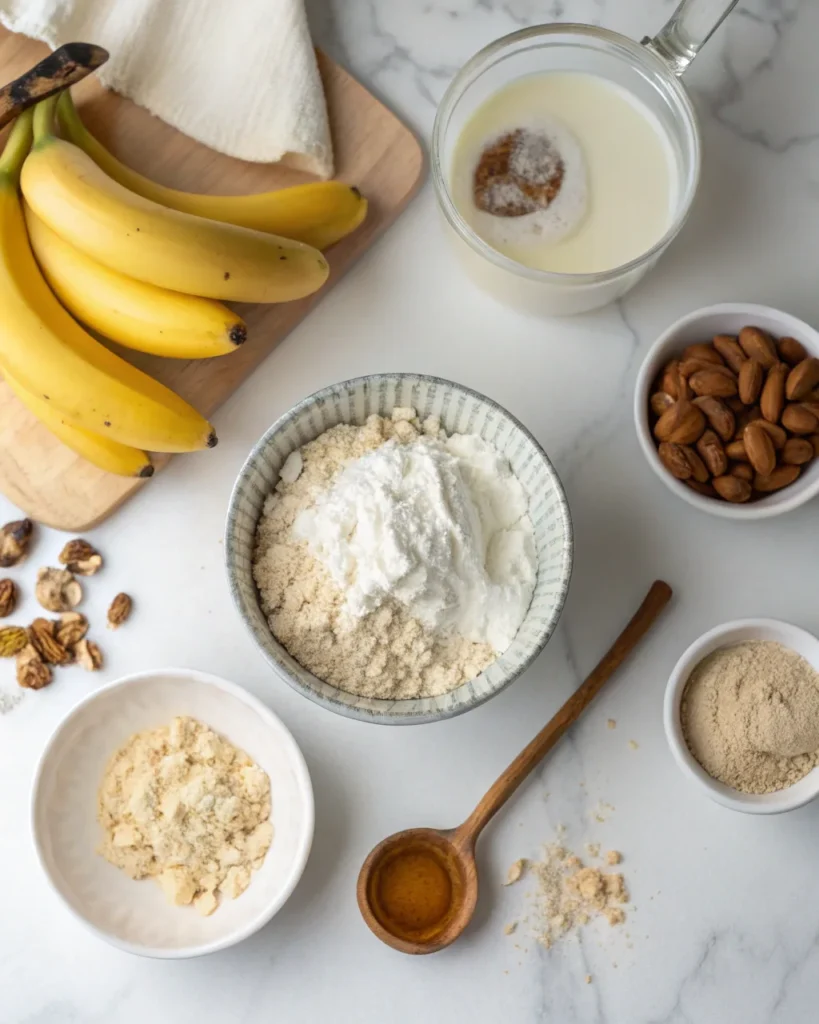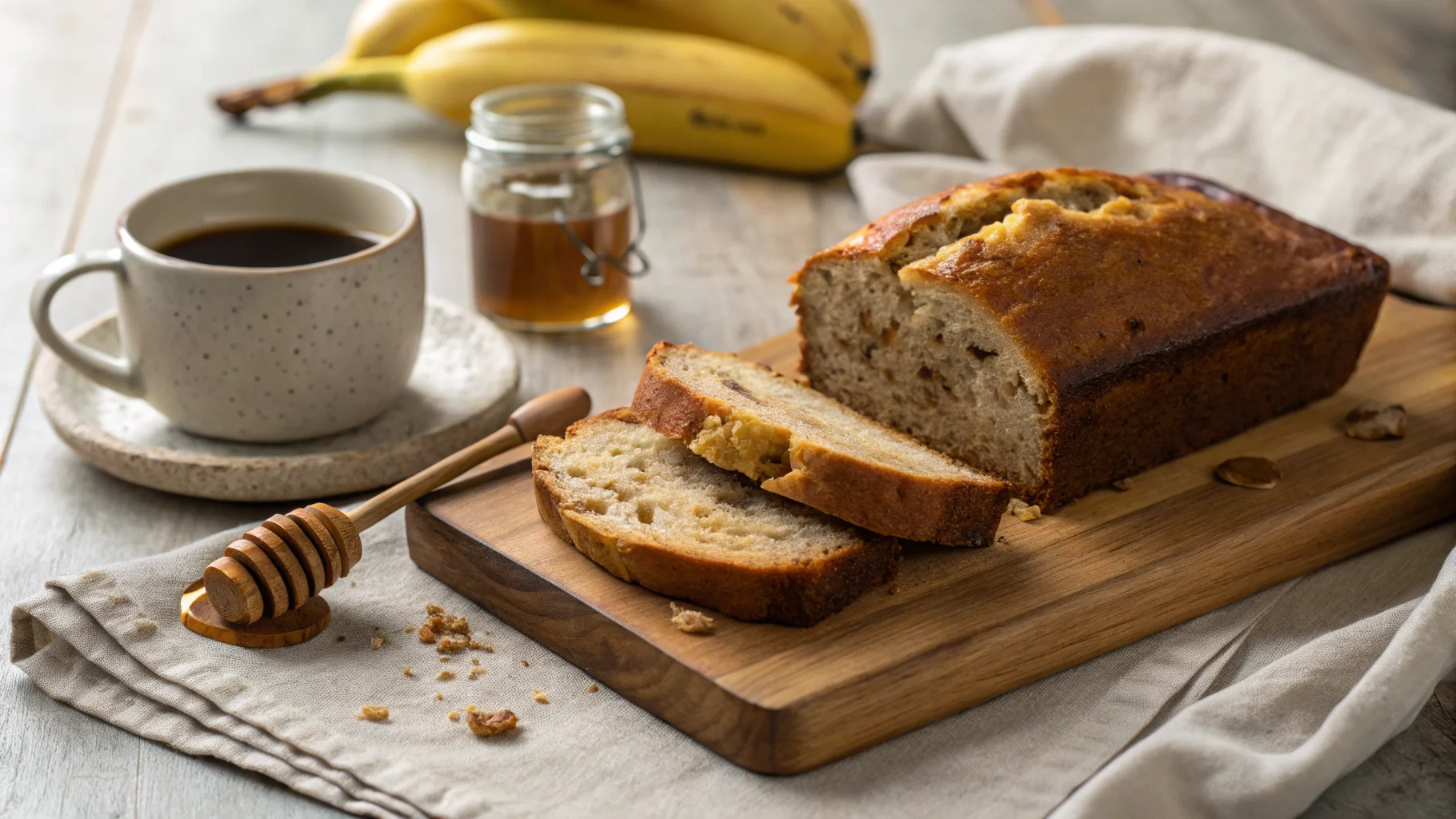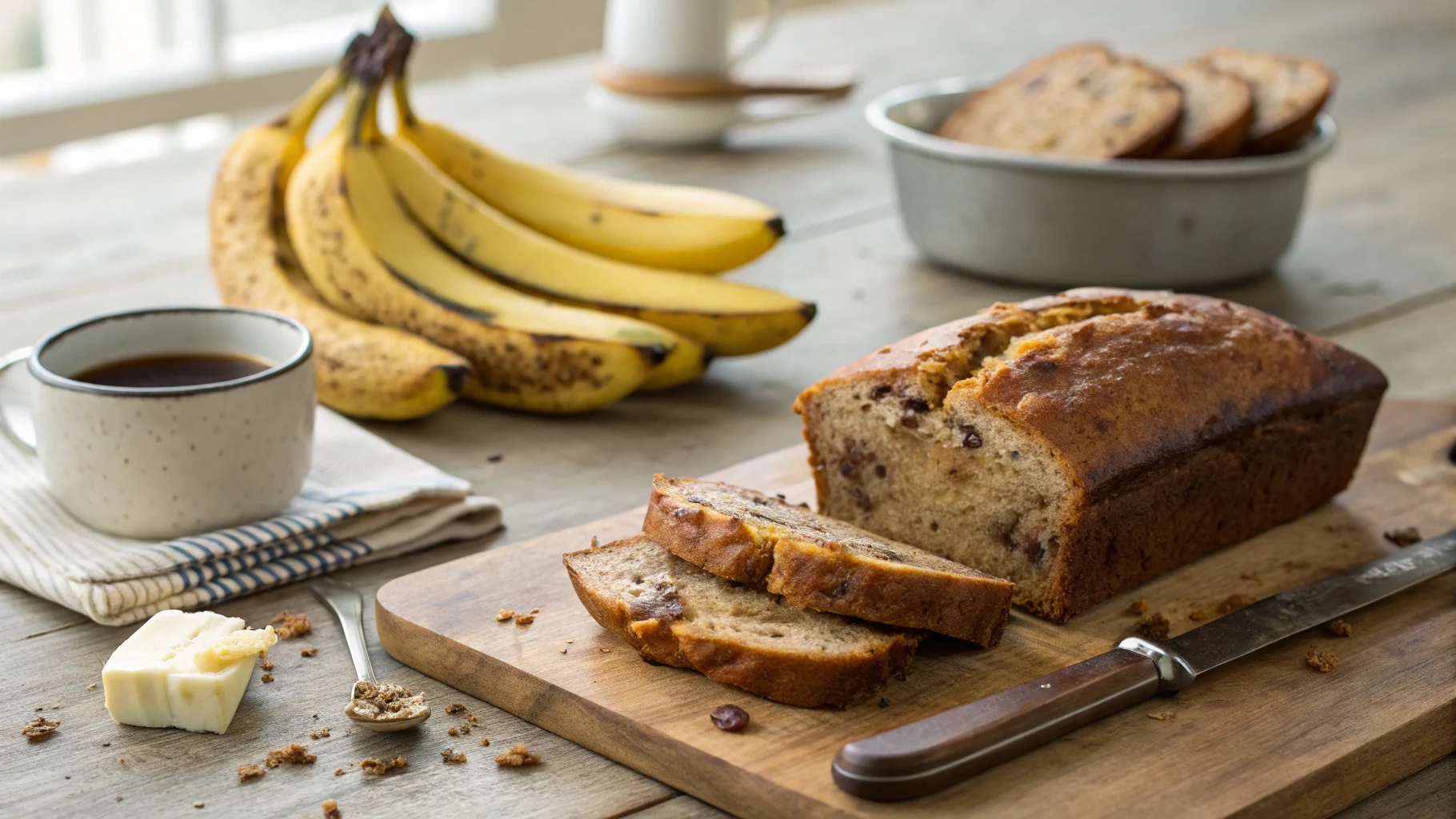Banana bread is a favorite comfort food, but if you’re trying to lose weight, you might wonder if it fits into a balanced diet. The good news is that you can enjoy banana bread while working toward your weight loss goals, as long as you make mindful choices.
Traditional banana bread recipes tend to be high in sugar, refined flour, and unhealthy fats, which can lead to excesBanana bread is a favorite comfort food, but many people ask, Can I eat banana bread while losing weight? The good news is that you can enjoy banana bread while working toward your weight loss goals, as long as you make mindful choices.
Traditional banana bread recipes tend to be high in sugar, refined flour, and unhealthy fats, which can lead to excess calorie consumption. However, with the right ingredient swaps and portion control, banana bread can be a nutritious addition to your diet.
If you’ve ever wondered, Can I eat banana bread while losing weight?, this guide will break down everything you need to know. You’ll learn about its nutritional value, its role in weight management, and how to make a healthier version. Plus, we’ll discuss how to include it in your diet without sabotaging your progress.s calorie consumption. However, with the right ingredient swaps and portion control, banana bread can be a nutritious addition to your diet.
This guide will break down everything you need to know about banana bread and weight loss. You’ll learn about its nutritional value, how bananas affect weight management, and ways to make a healthier version. Plus, we’ll discuss how to include it in your diet without sabotaging your progress.
table of contents
Understanding Banana Bread and Weight Loss
Banana bread is often viewed as a sweet treat, but its impact on weight loss depends on ingredients, portion sizes, and overall diet balance. While bananas themselves are nutrient-dense, traditional banana bread recipes include refined sugar, white flour, and butter—making them calorie-heavy.
However, making small adjustments to the recipe can lower the calorie count while increasing fiber and protein, helping to keep you full longer. Additionally, knowing when and how to eat banana bread plays a role in whether it supports or hinders your weight loss journey.
Nutritional Profile of Banana Bread
Calories, Sugar, and Carbohydrates in Traditional Recipes
A typical slice of homemade banana bread contains:
- Calories: Around 200-250 per slice
- Carbohydrates: 30-40g per slice
- Sugar: 12-20g, depending on added sweeteners
- Fat: 8-12g, primarily from butter or oil
Many store-bought or bakery versions contain even higher amounts of sugar and saturated fats, making them more calorie-dense. Consuming too much added sugar can lead to blood sugar spikes and crashes, making it harder to manage cravings.
Healthier Alternatives
If you want to enjoy banana bread while losing weight, consider these substitutions:
- Flour Alternatives: Use whole wheat flour, almond flour, or oat flour for added fiber and nutrients.
- Healthier Sweeteners: Replace white sugar with honey, maple syrup, or mashed bananas to reduce refined sugar intake.
- Healthy Fats: Swap butter for Greek yogurt, unsweetened applesauce, or coconut oil to lower saturated fat content.
- Added Nutrients: Mix in chia seeds, flaxseeds, or nuts for extra protein and fiber, helping with satiety.
Making these simple changes can significantly improve the nutritional profile of banana bread while keeping it delicious and satisfying.
The Role of Bananas in Weight Management
Bananas are a key ingredient in banana bread, but how do they affect weight loss? Contrary to the belief that bananas are “too high in carbs,” they can actually be beneficial when eaten in moderation.
Nutritional Benefits of Bananas
Bananas are naturally rich in:
- Potassium: Helps regulate fluid balance and muscle function, which is essential for an active lifestyle.
- Fiber: Supports digestion and promotes satiety, reducing the likelihood of overeating.
- Vitamins: High in vitamin B6 and C, contributing to overall health and metabolism support.
A medium banana contains about 105 calories and 3 grams of fiber, making it a nutrient-dense fruit that supports weight loss when eaten mindfully.
How Bananas Help with Hunger and Cravings
One of the biggest challenges in weight loss is managing hunger and cravings. Bananas can help because:
- They provide natural sweetness, which can curb sugar cravings and reduce the need for added sweeteners in recipes.
- They are rich in resistant starch, particularly when slightly unripe, which slows digestion and promotes fullness.
- They have a balanced combination of fiber and natural sugars, preventing energy crashes that lead to snacking.
Because bananas help regulate blood sugar levels and satiety, they can be a great addition to a weight loss diet when paired with protein and healthy fats.
Making Healthier Banana Bread Choices
Banana bread can be part of a weight loss plan, but traditional recipes are often loaded with refined flour, sugar, and unhealthy fats. However, with the right ingredient swaps and portion control, you can enjoy banana bread while staying on track with your goals.
If you have ever wondered, Can I eat banana bread while losing weight?, the key lies in making smart adjustments. By replacing processed ingredients with nutrient-dense alternatives, you can create a healthier version that supports your weight loss journey.
Ingredient Substitutions for Healthier Options
Modifying the ingredients in banana bread can improve its nutritional value, reduce empty calories, and boost fiber content. Instead of eliminating banana bread from your diet, try these substitutions to make it a better option.

Using Whole Grain or Alternative Flours
Traditional banana bread recipes rely on white flour, which is low in fiber and can cause blood sugar spikes. Instead, consider these healthier alternatives:
- Whole Wheat Flour: Contains more fiber and protein than refined flour, helping with satiety.
- Almond Flour: A low-carb option packed with healthy fats and protein, making banana bread more filling.
- Oat Flour: Provides a natural fiber boost, supporting digestion and blood sugar control.
- Coconut Flour: A gluten-free alternative that adds fiber but requires extra moisture in the recipe.
By replacing refined flour with one of these options, you can make banana bread more nutrient-dense and satisfying without compromising taste.
Reducing Added Sugars and Using Natural Sweeteners
Many banana bread recipes contain large amounts of sugar, which adds unnecessary calories and affects blood sugar levels. Instead of using white sugar, try these natural alternatives:
- Mashed Bananas: Naturally sweet and rich in fiber, reducing the need for additional sugar.
- Honey or Maple Syrup: Adds sweetness while offering trace nutrients and antioxidants.
- Stevia or Monk Fruit: Calorie-free natural sweeteners that provide sweetness without spiking blood sugar.
- Unsweetened Applesauce: A great substitute for sugar and butter, making banana bread moist and naturally sweet.
Reducing added sugar helps lower the calorie count of banana bread while making it a healthier option for weight loss.
Healthier Fat Replacements
Banana bread often contains butter or vegetable oil, which can increase calorie density. Instead, try these alternatives:
- Greek Yogurt: Adds protein and creaminess while reducing saturated fat.
- Coconut Oil: A healthier fat option that enhances moisture and flavor.
- Unsweetened Applesauce: Works as a fat substitute while keeping banana bread soft and moist.
- Nut Butters (Almond or Peanut Butter): Adds healthy fats and protein, improving satiety.
By making these simple swaps, banana bread becomes lighter, healthier, and more suitable for weight loss.
Portion Control and Serving Suggestions
Even with healthier ingredients, portion control is crucial. Overeating any food, even a healthy one, can make weight loss more challenging. If you are asking, Can I eat banana bread while losing weight?, the answer depends on how much and how often you eat it.

Recommended Serving Sizes for Weight Loss
A standard banana bread slice can range from 200-300 calories, depending on the ingredients used. To keep portions in check:
- Stick to one small slice: Around 1-inch thick or the size of your palm.
- Pre-slice the loaf: This makes portioning easier and prevents overeating.
- Use a muffin tin: Baking banana bread in muffin cups helps with portion control and meal prep.
- Track calories: If you’re on a calorie deficit, factor banana bread into your daily intake.
Eating banana bread in moderation allows you to enjoy it while staying within your weight loss goals.
Pairing Banana Bread with Proteins or Healthy Fats
Eating banana bread alone can lead to a quick spike in blood sugar, which may leave you feeling hungry sooner. To balance it out, pair it with protein or healthy fats for sustained energy.
Great pairings include:
- Greek Yogurt: Adds protein and probiotics, improving digestion and satiety.
- Nut Butter (Almond or Peanut Butter): Provides healthy fats and protein, keeping you full longer.
- Eggs: A protein-packed option that balances carbs and promotes muscle recovery.
- Cottage Cheese: A high-protein, low-fat dairy choice that complements banana bread.
- Chia or Flaxseeds: Sprinkle them on top for added fiber and omega-3 fatty acids.
Combining banana bread with nutrient-dense foods slows digestion and keeps you satisfied, making it easier to maintain a calorie deficit.
Incorporating Banana Bread into a Balanced Diet
Banana bread can be a part of a healthy, well-balanced diet, but timing and portion control play a crucial role. Many people wonder, Can I eat banana bread while losing weight? The answer depends on when and how you consume it.
Eating banana bread at the right times and pairing it with nutrient-dense foods can help manage blood sugar levels and prevent cravings. Additionally, practicing moderation ensures that you enjoy banana bread without exceeding your calorie goals.
Timing and Context for Consumption
The time you eat banana bread can influence energy levels, digestion, and hunger cues. Choosing the right moment helps maximize its benefits while minimizing its impact on weight loss.
Best Times to Eat Banana Bread
Eating banana bread at specific times of the day can help you stay full and energized. Consider these options:
- Pre-Workout: Provides a quick source of carbohydrates for sustained energy. Pair it with protein, like Greek yogurt or nuts, for better muscle support.
- Post-Workout: Helps replenish glycogen stores and promotes recovery, especially when combined with protein.
- Breakfast: Can be part of a balanced meal when paired with protein and fiber-rich foods, such as eggs or nut butter.
- Midday Snack: Keeps hunger at bay but should be portion-controlled to avoid excessive calorie intake.
Avoid eating banana bread late at night, as consuming too many carbohydrates before bed may lead to spikes in blood sugar levels, which can impact metabolism.
How to Fit Banana Bread into a Daily Meal Plan
If you’re trying to lose weight, fitting banana bread into your daily intake requires balance. Instead of eating it as a standalone treat, incorporate it into meals strategically.
- Pair with protein and fiber to slow digestion and reduce hunger.
- Track your portion size and stick to a small slice, ensuring you stay within your calorie goals.
- Choose a lower-calorie recipe by using whole grain flour, natural sweeteners, and healthier fats.
- Limit consumption to a few times per week rather than making it a daily habit.
By placing banana bread within a well-structured meal plan, you can enjoy it while maintaining a caloric deficit necessary for weight loss.
Moderation and Mindful Eating Practices
While banana bread can fit into a healthy diet, portion control is essential. Eating too much—even a healthier version—can lead to excess calorie consumption, which may slow down weight loss progress.
Importance of Moderation in Enjoying Treats
Many people struggle with portion control, especially with baked goods. To enjoy banana bread while losing weight:
- Stick to a reasonable portion, such as a 1-inch slice or a muffin-sized serving.
- Avoid eating it mindlessly, like while watching TV, as distractions can lead to overeating.
- Balance your intake by adjusting other meals if you plan to enjoy banana bread that day.
- Save it for special occasions rather than making it a daily staple.
Moderation ensures that banana bread remains a satisfying treat without negatively affecting your progress.
Tips for Mindful Eating to Enhance Satisfaction
Practicing mindful eating can help you enjoy banana bread without overindulging. Some effective strategies include:
- Slow down and savor each bite to recognize fullness cues.
- Use smaller plates or pre-cut slices to prevent overeating.
- Pair with protein or fiber to make the meal more balanced.
- Pay attention to hunger signals rather than eating out of habit.
When you listen to your body and eat with intention, you can enjoy banana bread while staying in control of your portions.
FAQs About Banana Bread and Weight Loss
People often have questions about whether banana bread can fit into a weight loss plan. Below are some of the most common concerns.
Can you eat banana bread on a diet?
Yes, but it depends on the ingredients and portion sizes. Traditional banana bread contains refined flour and sugar, which can be high in calories. However, by using whole grain flours, natural sweeteners, and healthy fats, you can make a lighter version.
If you practice portion control and balance it within your daily calorie intake, banana bread can be part of a healthy diet without disrupting weight loss progress.
Is it okay to eat bread when losing weight?
Bread is often seen as unhealthy, but it depends on the type you choose. Refined white bread lacks fiber and nutrients, making it less ideal for weight loss. However, whole grain, sprouted, or high-fiber bread can be beneficial.
If you enjoy banana bread, opt for whole wheat or oat flour versions, and pair it with protein or healthy fats to avoid blood sugar spikes. Eating bread in moderation can fit into a balanced diet without causing weight gain.
Can you eat bananas and still lose weight?
Absolutely. Bananas are rich in fiber, potassium, and vitamins, making them a great addition to a weight loss plan. They contain natural sugars, but their fiber content slows digestion, preventing blood sugar spikes.
To manage calorie intake, choose smaller bananas and pair them with protein or healthy fats, such as peanut butter or yogurt. Eating bananas in moderation supports digestion, muscle recovery, and satiety, all of which help with weight management.
Is banana bread healthy or unhealthy?
The healthiness of banana bread depends on its ingredients. A traditional recipe with white flour, sugar, and butter can be high in calories and refined carbohydrates, making it less ideal for weight loss.
A healthier version made with whole wheat flour, almond flour, or oat flour, along with natural sweeteners and healthier fats, provides more fiber and nutrients.
Banana bread can be a part of a balanced diet if consumed in moderation and made with nutritious ingredients.
Final Thoughts
So, Can I eat banana bread while losing weight? Yes, as long as you make healthier ingredient choices, control portion sizes, and eat it at the right times.
Instead of avoiding banana bread altogether, modify the recipe to include whole grain flour, natural sweeteners, and protein-rich additions. Also, practice mindful eating and balance it within your daily calorie intake.
By following these guidelines, you can enjoy banana bread as a nutritious and satisfying treat while staying on track with your weight loss goals.




